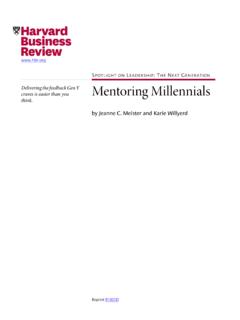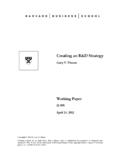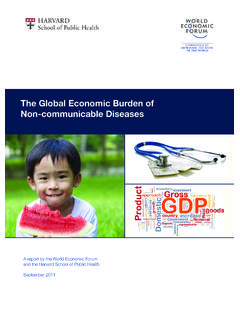Transcription of Spotlight on leaderShip Leadership Is A Conversation
1 June 2012. reprinT R1206D. Spotlight on Leadership Leadership Is A Conversation How to improve employee engagement and alignment in today's flatter, more networked organizations by Boris Groysberg and Michael Slind Spotlight on Leadership Spotlight Artwork Adam Ekberg Arrangement #1, 2009. Ink-jet print Leadership Is a Conversation How to improve employee engagement and alignment in today's flatter, more networked organizations by Boris Groysberg and Michael Slind 2 Harvard Business Review June 2012. For article reprints call 800-988-0886 or 617-783-7500, or visit Boris Groysberg is a professor of business administration at Harvard Business School. Michael Slind is a writer, editor, and communication consultant. They are the coauthors of Talk, Inc.: How Trusted Leaders Use Conversation to Power Their Organizations (Harvard Business Review Press, 2012). T. he command-and-control approach to management has in recent years become less and less viable.
2 Global- ization, new technologies, and changes in how companies cre- ate value and interact with cus- tomers have sharply reduced the efficacy of a purely directive, top- down model of Leadership . What will take the place of that model? Part of the answer lies in how leaders manage communication within their organizations . that is, how they handle the flow of information to, from, and among their employees. Traditional cor- porate communication must give way to a process that is more dynamic and more sophisticated. Most important, that process must be conversational. We arrived at that conclusion while conduct- ing a recent research project that focused on the state of organizational communication in the 21st century. Over more than two years we interviewed professional communicators as well as top leaders Copyright 2012 Harvard Business School Publishing Corporation. All rights reserved. June 2012 Harvard Business Review 3.
3 Spotlight on Leadership at a variety of organizations large and small, blue larly, requires leaders to minimize the distances . chip and start-up, for-profit and nonprofit, and institutional, attitudinal, and sometimes spatial . international. To date we have spoken with nearly that typically separate them from their employees. 150 people at more than 100 companies. Both im- Where conversational intimacy prevails, those with plicitly and explicitly, participants in our research decision- making authority seek and earn the trust mentioned their efforts to have a Conversation (and hence the careful attention) of those who work with their people or their ambition to advance the under that authority. They do so by cultivating the Conversation within their companies. Building upon art of listening to people at all levels of the organi- the insights and examples gleaned from this research, zation and by learning to speak with employees di- we have developed a model of Leadership that we call rectly and authentically.
4 Physical proximity between organizational Conversation . leaders and employees isn't always feasible. Nor is Smart leaders today, we have found, engage it essential. What is essential is mental or emotional with employees in a way that resembles an ordinary proximity. Conversationally adept leaders step down person- to-person Conversation more than it does from their corporate perches and then step up to the P. a series of commands from on high. Furthermore, challenge of communicating personally and trans- they initiate practices and foster cultural norms that parently with their people. instill a conversational sensibility throughout their This intimacy distinguishes organizational con- organizations. Chief among the benefits of this ap- versation from long-standard forms of corporate proach is that it allows a large or growing company to communication. It shifts the focus from a top-down function like a small one. By talking with employees, distribution of information to a bottom-up exchange rather than simply issuing orders, leaders can retain of ideas.
5 It's less corporate in tone and more casual. hysical proximity between leaders and employees isn't always feasible. But mental or emotional proximity is essential. or recapture some of the qualities operational flex- And it's less about issuing and taking orders than ibility, high levels of employee engagement, tight about asking and answering questions. strategic alignment that enable start-ups to out- Conversational intimacy can become manifest in perform better- established rivals. various ways among them gaining trust, listening In developing our model, we have identified four well, and getting personal. elements of organizational Conversation that reflect Gaining trust. Where there is no trust, there the essential attributes of interpersonal Conversation : can be no intimacy. For all practical purposes, the re- intimacy, interactivity, inclusion, and intentional- verse is true as well. No one will dive into a heartfelt ity.
6 Leaders who power their organizations through exchange of views with someone who seems to have Conversation -based practices need not (so to speak) a hidden agenda or a hostile manner, and any discus- dot all four of these i's. However, as we've discovered sion that does unfold between two people will be re- in our research, these elements tend to reinforce one warding and substantive only to the extent that each another. In the end, they coalesce to form a single in- person can take the other at face value. tegrated process. But trust is hard to achieve. In organizations it has become especially difficult for employees to put Intimacy: Getting Close trust in their leaders, who will earn it only if they are Personal Conversation flourishes to the degree that authentic and straightforward. That may mean ad- the participants stay close to each other, figuratively dressing topics that feel off-limits, such as sensitive as well as literally.
7 Organizational Conversation , simi- financial data. 4 Harvard Business Review June 2012. For article reprints call 800-988-0886 or 617-783-7500, or visit Idea in Brief One-way, top-down Today's leaders achieve far Corporate Conversation reflects The good news for leaders communication more engagement and cred- a new reality: Thanks in part to is that people can talk up a between leaders and ibility when they take part in digital and social technologies, company in a way that's more their employees is no genuine Conversation with the employees have found a public interesting and attractive than people who work for and with voice. They'll use it whether any obvious public relations longer useful or even them. A Conversation is a frank their bosses like it or not. campaign. realistic. exchange of ideas and informa- tion with an implicit or explicit agenda. Athenahealth, a medical-records technology employees at one session to grade him on a scale of provider, has gone as far as to treat every last one A to F.
8 The results, recorded anonymously, immedi- of its employees as an insider under the strict ately appeared on a screen for all to see. The grades legal meaning of the term. Insiders are defined were generally good, but less than half of employees as employees entrusted with strategic and finan- were willing to give him an A. He took the feedback cial information that could materially affect the seriously and began to conduct the exercise regu- company's business prospects and hence its stock larly. He also began asking open-ended questions price a status typically accorded only to top-tier about his performance. Somewhat ironically, he officers. Opening the books to such a degree was a found that internal communication was the area risky move, discouraged by the company's under- in which the highest number of participants be- writers and frowned upon by the SEC. But Athena lieved he had room for improvement. Even as Rogers health's leaders wanted employees to become sought to get close to employees by way of organiza- insiders in more than just the regulatory sense; tional Conversation , a fifth of his people were urging they wanted them to be thoroughly involved in the him to get closer still.
9 True listening involves tak- business. ing the bad with the good, absorbing criticism even Listening well. Leaders who take organizational when it is direct and personal and even when those Conversation seriously know when to stop talking delivering it work for you. and start listening. Few behaviors enhance conver- At Exelon, an energy provider headquartered sational intimacy as much as attending to what peo- in Chicago, a deeply personal form of organiza- ple say. True attentiveness signals respect for people tional Conversation emerged from a project aimed of all ranks and roles, a sense of curiosity, and even a at bringing the company's corporate values alive degree of humility. for its employees. Values statements typically do Duke Energy's president and CEO, James E. Rog- little to instill intimacy; they're generally dismissed ers, instituted a series of what he called listening as just talk. So Exelon experimented in its com- sessions when he was the CEO and chairman of Cin- munication about diversity, a core value: It used ergy (which later merged with Duke).
10 Meeting with a series of short video clips no fuss, no pretense, groups of 90 to 100 managers in three-hour sessions, no high production values of top leaders speak- he invited participants to raise any pressing issues. ing unscripted, very personally, about what diver- Through these discussions he gleaned information sity meant to them. They talked about race, sexual that might otherwise have escaped his attention. orientation, and other issues that rarely go on the At one session, for example, he heard from a group table in a corporation. Ian McLean, then an Exelon of supervisors about a problem related to uneven finance executive, spoke of growing up in Manches- compensation. You know how long it would have ter, England, the son of a working-class family, and Photography: frank Armstrong taken for that to bubble up in the organization? he feeling the sting of class prejudice. Responding to a asks. Having heard directly from those affected by question about a time when he felt different, he the problem, he could instruct his HR department to described going to work in a bank where most of find a solution right away.









